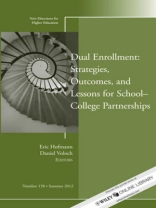This volume focuses on the goals, practices, policies, andoutcomes of programs that enroll high school students in collegecourses for college credit. This volume examines:
* The details of dual enrollment programs
* Their impact on student achievement and institutionalpractices
* How they support a student’s transition to, and successin, college
* The role of higher education in improving K-12education.
It presents quantitative and qualitative studies thatinvestigate the impact of dual enrollment programs on student andfaculty participants. Accounts by dual enrollment programadministrators provide examples of how their programs operate andhow data have been used to set benchmarks for program success.Chapters also explore models that build off dual enrollment’sphilosophy of school-college partnerships and embrace a morerobust framework for supporting college transition.
This is the 158th volume of this Jossey-Bass series.Addressed to higher education decision makers on all kinds ofcampuses, New Directions for Higher Education provides timely information andauthoritative advice about major issues and administrative problemsconfronting every institution.
İçerik tablosu
1. Why Dual Enrollment? 1
Eric Hofmann
This chapter outlines the contents of this volume and presents anoverview of dual enrollment within the context of a nationalcollegecompletion agenda.
Section I. Various Perspectives on Dual Enrollment
2. Does Dual Enrollment Increase Students’ Success in College? Evidence from a Quasi-Experimental Analysis of Dual Enrollment in New York City 11
Drew Allen, Mina Dadgar
Researchers review studies on dual enrollment and postsecondaryachievement and highlight their recent analysis of New York City’s College Now program.
3. ‘I don’t know, I’ve never been to college!’ Dual Enrollment as a College Readiness Strategy 21
Melinda Mechur Karp
This chapter uses student interviews and a theoretical framework ofanticipatory socialization and role rehearsal to understand theimpact of dual enrollment on students who participate.
4. Teaching and Learning in the Dual Enrollment Classroom29
Katherine L. Hughes, Linsey Edwards
Researchers use qualitative data from California’s Concurrent Courses Initiative to understand the impact of dual enrollmentprograms on pedagogical strategies.
5. The Impact of Dual Enrollment on the Institution39
Katherine N. Kinnick
The director of a dual enrollment honors program discusses thevalue of dual enrollment programs to universities whilehighlighting programmatic concerns and challenges.
6. Data-Informed Practices in an Urban Dual Enrollment Program 49
Jeanette Kim
This chapter describes how data inform program priorities andbenchmarks for success in a systemwide dual enrollment program in New York City.
7. Dual Enrollment in the Broader Context of College-Level High School Programs 59
Kristin Klopfenstein, Kit Lively
This chapter provides an overview of some differences between dualenrollment and Advanced Placement programs, including theirorigins, the curriculum, and impact on postsecondaryachievement.
Section II. Dual Enrollment Models That Strengthen School-College Partnerships
8. Using College Placement Exams as Early Signals of College Readiness: An Examination of California’s Early Assessment Programand New York’s At Home in College Program 71
Andrea Venezia, Daniel Voloch
This chapter explores the use of college placement exams andspecially designed courses in order to improve alignment betweensecondary and postsecondary institutions.
9. Early Colleges: A New Model of Schooling Focusing on College Readiness 81
Julie A. Edmunds
This chapter presents quantitative and qualitative data from anexperimental study of early college high schools in North Carolina, as well as an overview of national studies of early colleges.
10. Dual Enrollment Lessons and the Development of The New Community College at CUNY 91
Tracy Meade
The former project director discusses the influence of dualenrollment programs on the planning of a new community college.
11. Dual Enrollment as a Liminal Space 101
Eric Hofmann, Daniel Voloch
The authors propose a new metaphor for thinking about dualenrollment programs as a strategy to support successful collegetransition.
INDEX 109
Yazar hakkında
Eric Hoffman and Daniel Voloch are the authors of Dual Enrollment: Strategies, Outcomes, and Lessons for School-College Partnerships: New Directions for Higher Education, Number 158, published by Wiley.












